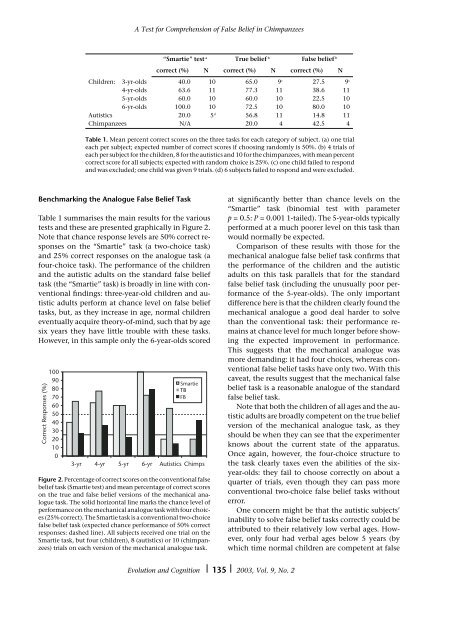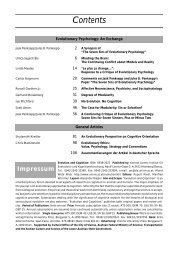Contents - Konrad Lorenz Institute
Contents - Konrad Lorenz Institute
Contents - Konrad Lorenz Institute
Create successful ePaper yourself
Turn your PDF publications into a flip-book with our unique Google optimized e-Paper software.
A Test for Comprehension of False Belief in Chimpanzees<br />
“Smartie” test a True belief b False belief b<br />
correct (%) N correct (%) N correct (%) N<br />
Children: 3-yr-olds 40.0 10 65.0 9 c 27.5 9 c<br />
4-yr-olds 63.6 11 77.3 11 38.6 11<br />
5-yr-olds 60.0 10 60.0 10 22.5 10<br />
6-yr-olds 100.0 10 72.5 10 80.0 10<br />
Autistics 20.0 5 d 56.8 11 14.8 11<br />
Chimpanzees N/A 20.0 4 42.5 4<br />
Table 1. Mean percent correct scores on the three tasks for each category of subject. (a) one trial<br />
each per subject; expected number of correct scores if choosing randomly is 50%. (b) 4 trials of<br />
each per subject for the children, 8 for the autistics and 10 for the chimpanzees, with mean percent<br />
correct score for all subjects; expected with random choice is 25%. (c) one child failed to respond<br />
and was excluded; one child was given 9 trials. (d) 6 subjects failed to respond and were excluded.<br />
Benchmarking the Analogue False Belief Task<br />
Table 1 summarises the main results for the various<br />
tests and these are presented graphically in Figure 2.<br />
Note that chance response levels are 50% correct responses<br />
on the “Smartie” task (a two-choice task)<br />
and 25% correct responses on the analogue task (a<br />
four-choice task). The performance of the children<br />
and the autistic adults on the standard false belief<br />
task (the “Smartie” task) is broadly in line with conventional<br />
findings: three-year-old children and autistic<br />
adults perform at chance level on false belief<br />
tasks, but, as they increase in age, normal children<br />
eventually acquire theory-of-mind, such that by age<br />
six years they have little trouble with these tasks.<br />
However, in this sample only the 6-year-olds scored<br />
Correct Responses (%)<br />
100<br />
90<br />
80<br />
70<br />
60<br />
50<br />
40<br />
30<br />
20<br />
10<br />
0<br />
Smartie<br />
TB<br />
FB<br />
3-yr 4-yr 5-yr 6-yr Autistics Chimps<br />
Figure 2. Percentage of correct scores on the conventional false<br />
belief task (Smartie test) and mean percentage of correct scores<br />
on the true and false belief versions of the mechanical analogue<br />
task. The solid horizontal line marks the chance level of<br />
performance on the mechanical analogue task with four choices<br />
(25% correct). The Smartie task is a conventional two-choice<br />
false belief task (expected chance performance of 50% correct<br />
responses: dashed line). All subjects received one trial on the<br />
Smartie task, but four (children), 8 (autistics) or 10 (chimpanzees)<br />
trials on each version of the mechanical analogue task.<br />
at significantly better than chance levels on the<br />
“Smartie” task (binomial test with parameter<br />
p = 0.5: P = 0.001 1-tailed). The 5-year-olds typically<br />
performed at a much poorer level on this task than<br />
would normally be expected.<br />
Comparison of these results with those for the<br />
mechanical analogue false belief task confirms that<br />
the performance of the children and the autistic<br />
adults on this task parallels that for the standard<br />
false belief task (including the unusually poor performance<br />
of the 5-year-olds). The only important<br />
difference here is that the children clearly found the<br />
mechanical analogue a good deal harder to solve<br />
than the conventional task: their performance remains<br />
at chance level for much longer before showing<br />
the expected improvement in performance.<br />
This suggests that the mechanical analogue was<br />
more demanding: it had four choices, whereas conventional<br />
false belief tasks have only two. With this<br />
caveat, the results suggest that the mechanical false<br />
belief task is a reasonable analogue of the standard<br />
false belief task.<br />
Note that both the children of all ages and the autistic<br />
adults are broadly competent on the true belief<br />
version of the mechanical analogue task, as they<br />
should be when they can see that the experimenter<br />
knows about the current state of the apparatus.<br />
Once again, however, the four-choice structure to<br />
the task clearly taxes even the abilities of the sixyear-olds:<br />
they fail to choose correctly on about a<br />
quarter of trials, even though they can pass more<br />
conventional two-choice false belief tasks without<br />
error.<br />
One concern might be that the autistic subjects’<br />
inability to solve false belief tasks correctly could be<br />
attributed to their relatively low verbal ages. However,<br />
only four had verbal ages below 5 years (by<br />
which time normal children are competent at false<br />
Evolution and Cognition ❘ 135 ❘ 2003, Vol. 9, No. 2








